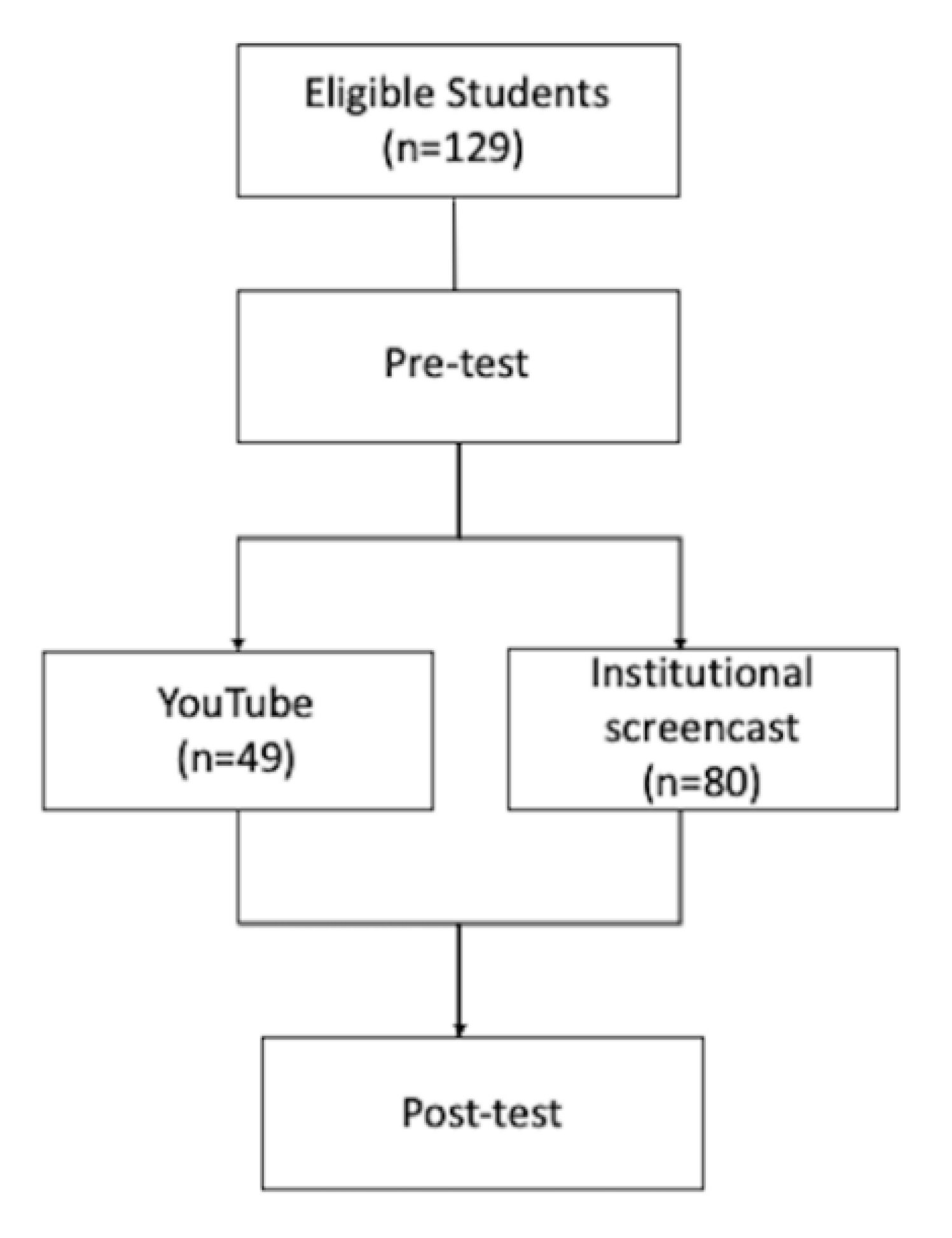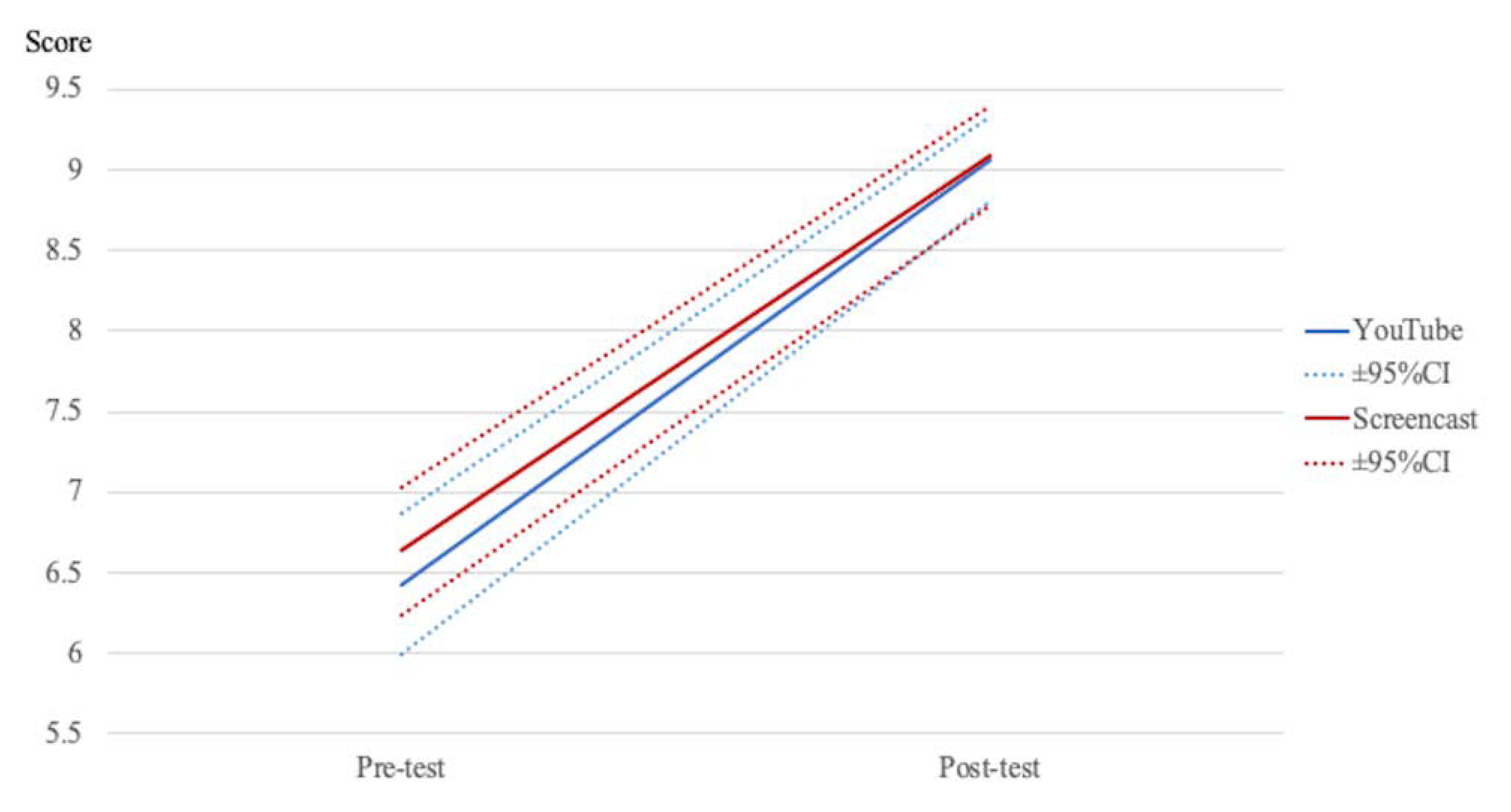Evaluating Effectiveness of YouTube Videos for Teaching Medical Students CPR: Solution to Optimizing Clinician Educator Workload during the COVID-19 Pandemic
Abstract
1. Introduction
2. Materials and Methods
2.1. Study Design and Participants
2.2. Study Setting
2.3. Study Protocol
2.4. Intervention (YouTube)
2.5. Data Analysis
2.6. Ethical Considerations
3. Results
4. Discussion
5. Conclusions
Supplementary Materials
Author Contributions
Funding
Institutional Review Board Statement
Informed Consent Statement
Data Availability Statement
Acknowledgments
Conflicts of Interest
References
- Al-Balas, M.; Al-Balas, H.I.; Jaber, H.M.; Obeidat, K.; Al-Balas, H.; Aborajooh, E.A.; Al-Taher, R.; Al-Balas, B. Distance learning in clinical medical education amid COVID-19 pandemic in Jordan: Current situation, challenges, and perspectives. BMC Med. Educ. 2020, 20, 341. [Google Scholar] [CrossRef] [PubMed]
- Hagana, A.; Cecula, P. Medical students in the time of COVID-19: Opportunities and challenges. AEM Educ. Train. 2020, 4, 291. [Google Scholar] [CrossRef] [PubMed]
- Das, D.; Lall, M.D.; Walker, L.; Dobiesz, V.; Lema, P.; Agrawal, P. The multifaceted impact of COVID-19 on the female academic emergency physician: A national conversation. AEM Educ. Train. 2020, 5, 91–98. [Google Scholar] [CrossRef]
- Nomura, O.; Nonogi, H.; Hanada, H. Do-It-Yourself (DIY) disposable aerosol box. J. Emerg. Med. 2020, 59, e154–e155. [Google Scholar] [CrossRef]
- Nomura, O.; Mishina, H.; Kobayashi, Y.; Ishiguro, A.; Sakai, H.; Kato, H. Limitation of duty hour regulations for pediatric resident wellness: A mixed-methods study in Japan. Medicine 2016, 95, e4867. [Google Scholar] [CrossRef]
- Zaidi, S.R.; Sharma, V.K.; Tsai, S.L.; Flores, S.; Lema, P.C.; Castillo, J. Emergency department well-being initiatives during the COVID-19 pandemic: An after-action review. AEM Educ. Train. 2020, 4, 411–414. [Google Scholar] [CrossRef] [PubMed]
- Grock, A.; Chan, W.; Aluisio, A.R.; Alsup, C.; Huang, D.; Joshi, N. Holes in the FOAM: An analysis of curricular comprehensiveness in online educational resources. AEM Educ. Train. 2020. [Google Scholar] [CrossRef]
- Pescatore, R.M.; Niforatos, J.D.; Rezaie, S.R.; Swaminathan, A.; Morrison, M.; Reid, M.; Motov, S. FOAM Impact: The influence of open-access medical education on practice uptake. AEM Educ. Train. 2020, 4, 239–243. [Google Scholar] [CrossRef] [PubMed]
- Spence, A.D.; Derbyshire, S.; Walsh, I.K.; Murray, J.M. Does video feedback analysis improve CPR performance in phase 5 medical students? BMC Med. Educ. 2016, 16, 203. [Google Scholar] [CrossRef][Green Version]
- Lehmann, R.; Lutz, T.; Helling-Bakki, A.; Kummer, S.; Huwendiek, S.; Bosse, H.M. Animation and interactivity facilitate acquisition of pediatric life support skills: A randomized controlled trial using virtual patients versus video instruction. BMC Med. Educ. 2019, 19, 7. [Google Scholar] [CrossRef]
- Yaylaci, S.; Serinken, M.; Eken, C.; Karcioglu, O.; Yılmaz, A.; Elicabuk, H.; Dal, O. Are YouTube videos accurate and reliable on basic life support and cardiopulmonary resuscitation? Emerg. Med. Australas. 2014, 26, 474–477. [Google Scholar] [CrossRef]
- Yilmaz Ferhatoglu, S.; Kudsioglu, T. Evaluation of the reliability, utility, and quality of the information in cardiopulmonary resuscitation videos shared on Open access video sharing platform YouTube. Australas. Emerg. Care 2020, 23, 211–216. [Google Scholar] [CrossRef]
- Thoma, B.; Chan, T.M.; Kapur, P.; Sifford, D.; Siemens, M.; Paddock, M.; Ankel, F.; Grock, A.; Lin, M.; Alexander, C.; et al. The Social Media Index as an Indicator of Quality for Emergency Medicine Blogs: A METRIQ Study. Ann. Emerg. Med. 2018, 72, 696–702. [Google Scholar] [CrossRef] [PubMed]
- Colmers-Gray, I.N.; Krishnan, K.; Chan, T.M.; Trueger, N.S.; Do, M.M.P.; Grock, A.; Zaver, F.; Thoma, B. The Revised METRIQ Score: A Quality Evaluation Tool for Online Educational Resources. AEM Educ. Train. 2019, 3, 387–392. [Google Scholar] [CrossRef] [PubMed]
- Woods, J.M.; Chan, T.M.; Roland, D.; Riddell, J.; Tagg, A.; Thoma, B. Evaluating the reliability of gestalt quality ratings of medical education podcasts: A METRIQ study. Perspect. Med. Educ. 2020, 9, 302–306. [Google Scholar] [CrossRef] [PubMed]
- Zoll Medical. Is There a Treatment for Sudden Cardiac Arrest? Available online: https://youtu.be/LLZRNEshWh4 (accessed on 10 April 2021).
- Zoll Medical. How to Respond to Sudden Cardiac Arrest. Available online: https://youtu.be/DByqyhLV1zg (accessed on 10 April 2021).
- Japan Resuscitation Council. Learn CPR and How to Use AED. Available online: https://www.japanresuscitationcouncil.org/倒れた人を目の前にして/誰でも使えるaed/ (accessed on 1 April 2021).
- Lynes, C.W.; Toft, L.E.B. Availability and Quality of Internet-Based Cardiopulmonary Resuscitation Training Films Featuring Women Experiencing Cardiac Arrest. JAMA Cardiol. 2020, 5, 1448–1449. [Google Scholar] [CrossRef]
- Murugiah, K.; Vallakati, A.; Rajput, K.; Sood, A.; Challa, N.R. YouTube as a source of information on cardiopulmonary resuscitation. Resuscitation 2011, 82, 332–334. [Google Scholar] [CrossRef]
- Desy, J.R.; Reed, D.A.; Wolanskyj, A.P. Milestones and millennials: A perfect pairing—Competency-based medical education and the learning preferences of generation Y. Mayo Clin. Proc. 2017, 92, 243–250. [Google Scholar] [CrossRef]
- Rapp, A.K.; Healy, M.G.; Charlton, M.E.; Keith, J.N.; Rosenbaum, M.E.; Kapadia, M.R. YouTube is the most frequently used educational video source for surgical preparation. J. Surg. Educ. 2016, 73, 1072–1076. [Google Scholar] [CrossRef] [PubMed]
- Khamees, D.; Brown, C.A.; Arribas, M.; Murphey, A.C.; Haas, M.R.C.; House, J.B. In Crisis: Medical students in the COVID-19 pandemic. AEM Educ. Train. 2020, 4, 284–290. [Google Scholar] [CrossRef]
- Nomura, O.; Wiseman, J.; Sunohara, M.; Akatsu, H.; Lajoie, S.P. Japanese medical learners’ achievement emotions: Accounting for culture in translating Western medical educational theories and instruments into an asian context. Adv. Health Sci. Educ. 2021, 1–22. [Google Scholar] [CrossRef]


| Type | Test | n | Mean | SD |
|---|---|---|---|---|
| YouTube | Pre-Test | 49 | 6.43 | 1.54 |
| Post-Test | 49 | 9.06 | 0.92 | |
| Screencast by Instructor | Pre-Test | 80 | 6.64 | 1.77 |
| Post-Test | 80 | 9.09 | 1.37 | |
| Overall | Pre-Test | 129 | 6.56 | 1.69 |
| Post-Test | 129 | 9.08 | 1.22 |
Publisher’s Note: MDPI stays neutral with regard to jurisdictional claims in published maps and institutional affiliations. |
© 2021 by the authors. Licensee MDPI, Basel, Switzerland. This article is an open access article distributed under the terms and conditions of the Creative Commons Attribution (CC BY) license (https://creativecommons.org/licenses/by/4.0/).
Share and Cite
Nomura, O.; Irie, J.; Park, Y.; Nonogi, H.; Hanada, H. Evaluating Effectiveness of YouTube Videos for Teaching Medical Students CPR: Solution to Optimizing Clinician Educator Workload during the COVID-19 Pandemic. Int. J. Environ. Res. Public Health 2021, 18, 7113. https://doi.org/10.3390/ijerph18137113
Nomura O, Irie J, Park Y, Nonogi H, Hanada H. Evaluating Effectiveness of YouTube Videos for Teaching Medical Students CPR: Solution to Optimizing Clinician Educator Workload during the COVID-19 Pandemic. International Journal of Environmental Research and Public Health. 2021; 18(13):7113. https://doi.org/10.3390/ijerph18137113
Chicago/Turabian StyleNomura, Osamu, Jin Irie, Yoonsoo Park, Hiroshi Nonogi, and Hiroyuki Hanada. 2021. "Evaluating Effectiveness of YouTube Videos for Teaching Medical Students CPR: Solution to Optimizing Clinician Educator Workload during the COVID-19 Pandemic" International Journal of Environmental Research and Public Health 18, no. 13: 7113. https://doi.org/10.3390/ijerph18137113
APA StyleNomura, O., Irie, J., Park, Y., Nonogi, H., & Hanada, H. (2021). Evaluating Effectiveness of YouTube Videos for Teaching Medical Students CPR: Solution to Optimizing Clinician Educator Workload during the COVID-19 Pandemic. International Journal of Environmental Research and Public Health, 18(13), 7113. https://doi.org/10.3390/ijerph18137113






